Naikari 0.1.0
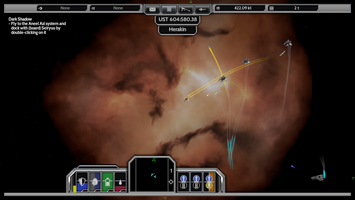

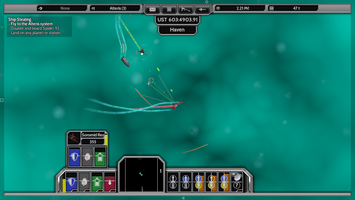
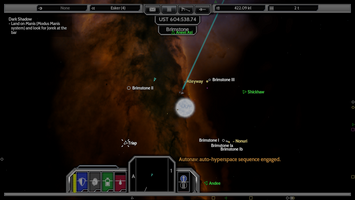

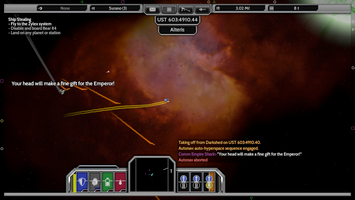

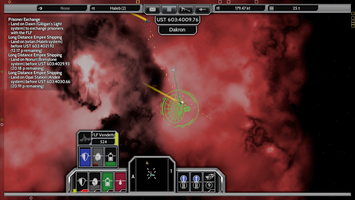
This is the first release of Naikari, a new space-trading and mercenary sandbox game we are developing. Well, we say “new”, but this is a fork of Naev. We previously were a major contributor to that project for about seven years and Naikari is essentially a continuation of what we were trying to do with Naev. We hope you enjoy the release! For screenshots, see the Naikari website.
Changes Compared to Naev
It should be noted that Naikari does not define itself by its relation to Naev. However, as Naev is the more well-known project and this project stems from our efforts to contribute to the Naev project, it may be useful to talk about how Naikari compares to Naev as it was when we split off from that project, which was shortly before the 0.8.0 release (around early December 2020). Note that some of these changes have made their way over to Naev as well, either because we submitted pull requests or because the Naev developers pulled them, or in some cases because a Naev maintainer independently made the decision to make the same change after we did. So if you find that Naev has some of these described changes, that’s why. This list does not include changes that were originally in the Naev project and then ported over to Naikari, or changes that were directly inspired by Naev’s changes.
As a general rule, Naikari has not pulled changes from Naev since forking with the exception of changes that benefit Naikari’s purpose (where we’ve noticed them). As such, things like the visual novel system, stealth, safe lanes, and map eyecandy are not in Naikari, but things like ship trails, the new nebulae, and various engine improvements have been pulled from upstream.
The following are noteworthy changes Naikari has made since the time it was forked from Naev.
Interface Changes
The interface has been substantially revamped. We didn’t manage to do all of the interface changes we wanted to for the initial release (in particular we haven’t finished the new “Neo” GUI we started working on), but the changes are quite significant nonetheless. Most notably:
- Increased the size of text in most places.
- The game no longer barks at you for choosing the name of the ship you just traded in for your new ship when doing a trade-in; it now seamlessly allows it by using some renaming trickery.
- Rearranged the contents of several windows to make better use of space and/or avoid overflowing text.
- Units used for displaying various important stats have been changed. ¤ is replaced with ¢, fuel is in hL instead of “units”, energy units are GJ and GW instead of MJ and MW, and distances are in kilometers instead of meters. Acceleration (previously referred to as “thrust”) is now described directly as km/s², as well.
- Improved the aiming helper and enabled both it and firing only in range by default. The aiming helper now adjusts its aiming lines based on the arc or swivel of your weapons that are in-range, rather than showing a static 30° arc. It also hides the aiming crosshair if none of your weapons are in range, which allows a visual indication of whether you’re in range or not, and automatically places the crosshair in the aiming circle if using turreted weapons since your orientation is irrelevent in that case.
- You can now sell outfits from the Equipment tab, albeit only one outfit at a time.
- Fueling from ships out in space is now always done in increments that make sense, where possible. For example, if you consume 400 hL of fuel per jump, any ship which fuels you will attempt to provide 400 hL of fuel and only offer less if they can’t give you that much (and the dialog box always tells you how much fuel you’re getting).
- Weapon damage amounts are now shown as separate values indicating shield, armor, and knockback damage, making it clearer how similar weapons differ from each other.
- American spellings are used instead of British spellings (most notably changing “armour” to “armor”). We have nothing against British spellings but we’re an American English speaker and so writing is a lot easier that way.
- For outfits that are limited to one per type, the type is shown so the player can tell what it is one of that they are limited to exactly.
- Added automatic landing, engaged either by double-clicking a planet or by pressing “L”. Automatic landing takes care of all landing procedures, up to and including prompting the player with the hail prompt when close enough if bribing is necessary. (Automatic boarding has also been imported from Naev, which added it after we added automatic landing.)
- Double-clicking on a jump gate or pressing “J” now enables autonav instead of attempting a manual jump, matching how it now works for planets.
- Instead of asking for a speed setting when a game is started, the Options menu now has a game speed setting controlled by a slider which ranges from 25% to 100%. (The previous “Slow Mode” ran at 50%.)
- Improved colorblind accessibility.
- The Equipment screen’s display of a ship’s stats has been significantly polished, making it more accurately portray what’s happened to a ship’s stats as a result of outfits equipped to it.
- Automatic planet selection when pressing “L” has been improved and adapted to the control’s new role of initiating autonav. Instead of merely targeting the closest planet and attempting to land, it now specifically tries to choose the most suitable planet to land on (preferring planets you can land on without bribing) and choosing the nearest of those candidates. It also spits out an error when no suitable planet could be found (and auto jump selection with the J key does this as well, though that is unlikely to be encountered organically in normal gameplay).
- Improved mouse flying. Instead of accelerating based on how close to the edge of the screen the mouse pointer is, thrusting is controlled manually either with the normal thrust key or by pressing the middle mouse or one of the extra mouse buttons. This means that using middle-click to toggle mouse flying is no longer supported. It also means that the option for whether mouse flight should control thrust is obsolete, and therefore has been removed. The option to outright disable mouse flight (which only had the effect of making Ctrl+X not work) has been removed, as well.
- The Brushed GUI now allows you to issue orders to escorts (as with the keyboard) with a button that gives you a menu.
- You can now hail escorts to give them orders individually (with the exception of the attack command, since that requires you to target an enemy). This works with fighter bay fighters as well as hired escorts.
- The game no longer stops you from opening the Info window when the player’s ship is being controlled by a mission.
Starmap Changes
The starmap has gotten quite a lot of attention on its own. Most notably, the following changes have happened to Naikari’s starmap:
- No longer spoils what the dominant faction is of a system before you have the information to know, nor does it spoil whether or not there’s a planet you can land on before you have the information to know. All systems for which you know of no planet show up as empty even if a planet exists there, and your map then progressively fills up information as you discover it. For example, if a system has Empire and Dvaered planets but dominant Empire presence, instead of immediately knowing this, you initially only see an empty system on the map. If you then discover a Dvaered planet first, the map will show it as Dvaered dominant, up until the point when you discover an Empire asset. In short, the map now properly represents what you know without giving you any details that you don’t yet know.
- Now shows exactly how much damage each system with a nebula inflicts in GW, and exactly how much visibility is reduced.
- Now shows coloring and symbols for services available in any given system, allowing you to know e.g. that refueling is available on an asset you can land on but that the shipyard is only available on a restricted asset.
- Map mode is now remembered after closing the map and returned to when you re-open it.
- No longer forgets previous autonav paths when you close and re-open it.
- Now shows some information that can be useful for travel, such as your fuel and current system, below the map.
- All map modes now show your currently selected path and mission markers, just dimly on those where they were previously omitted.
- Now uses the “restricted” color for systems which only have restricted assets (like Fortitude). It still doesn’t achieve perfect parity with planet and services designations (this is impossible without e.g. labeling Raelid as restricted even though there’s an asset you can land on there), but it’s closer.
Mission Changes
All missions have been touched up one way or another, and some missions have been removed because we either don’t want them in Naikari or want to rewrite them from scratch. Most noteworthy mission changes:
- Mission computer titles (such as those for cargo missions) are now formulated to be more uniform and concise.
- Removed the Heretic campaign, which wasn’t really designed all that well and could easily lead the player into an essentially unwinnable state.
- Removed the Sirius ferry mission; the mission has architectural problems that make it easier to replace entirely with a new mission than to try to fix the existing mission. Will be replaced with a better ferry mission later on.
- Started expanding the FLF campaign, but cut off access to the end of the campaign until the expansions are completed. (The end content is still there, just temporarily inaccessible.)
- Reworked the Coming Out campaign into a much better story.
- Removed the Collective campaign. We will be telling an entirely different story with the Collective faction.
- Removed the Empire Long Distance Recruitment campaign and made long distance Empire shipping missions available immediately when you’re recruited by the Empire.
- With some targeted exceptions, all missions now increase reputation in a way that causes loss of reputation with the faction’s enemies.
- The “Fake ID” mission no longer has a chance to mess up long-term progress, but your true identity can now be discovered randomly if you gain reputation over 20 with a fake ID.
- The ship stealing mission now has you actually disable and board the ship you’re stealing (instead of just landing on a planet), and it also grants you all of the outfits it was equipped with.
- Patrol missions now only show up in systems where the payer has dominant presence in a numbers sense over all of its enemies. This avoids generating frustrating patrol missions.
- Frontier War campaign has been removed. We will be doing our own Frontier invasion campaign, which will be playable from either side depending on alignment.
- Removed the second Dvaered anti-FLF mission and temporarily disabled the last anti-FLF mission; we will be expanding the anti-FLF campaign in the future and touching up the conclusion, including making discovery of the FLF base’s location more interesting and integrating it better into the FLF campaign’s storyline.
- Expanded the tutorial to hopefully be clearer, and added a couple more pointed tutorial interjections (in particular for boarding). We will be extending this further in the future with extended tutorials and repeatable practice missions.
- Added tutorial logs which can be looked back to for a quick refresher.
- Removed rehabilitation missions on the grounds that they allow a far too easy “Switzerland approach”. This was especially important since pirate reputation is no longer controlled by a need to conduct more and more piracy.
- More legal locations are now available for the Waste Dump mission.
- Removed several low-quality single-system one-off missions that we decided weren’t worth fixing up. Some examples: Kidnapped, Defend The System, Crimelord, Dvaered Championship.
- Removed the Science Gone Wrong campaign as it was low-quality and isn’t an idea we want to utilize.
- Added a new generic “Love Train” mission, where you deliver special packages for lovers.
- Replaced the Za’lek Test mission with a new implementation that works better. The engine itself is now what causes malfunctions, via a special event, and it’s possible to acquire one of the engines for real use with a bit of trickery (malfunctions still happen even if the Za’lek Test mission is inactive).
Outfit Changes
Outfit balance has been completely redone. In particular, the following changes have been made to outfits:
- Removed the “accessory” slot and all accessories.
- Weapons have been streamlined to avoid redundant, low-class outfits. All weapons are now designed to serve a particular purpose, with them now essentially following a tiered system: ultralight, light, Corvette, medium, heavy, and capital class. This builds on the missile rebalancing we did for Naev years ago.
- Basic weapon types now are: laser (normal fire rate, equal shield and armor damage); Razor (normal fire rate, higher shield damage and lower armor damage); kinetic (rapid fire rate, slow speed, halved energy consumption, higher armor damage and lower shield damage, knockback); and plasma (slow fire rate, higher armor damage and lower shield damage).
- Every faction has one or two “factional outfits” which you can only get from their military stations. For Empire it’s the Turbolaser and Empire Lancelot fighter bays, for Dvaered it’s the Repeating Railgun and Active Plating, for Sirius it’s Heavy Razor Turret and Sirius Fidelity fighter bays, and for Za’lek it’s the Hunter/Reaper launchers and drone fighter bays. (For Soromid, nearly all of their outfits are “factional” in this way, the Plasma Cluster Cannon being the only exception.)
- Several modifier outfits are now utilities instead of structurals, making them more useful as they no longer have to take up a valuable structural slot.
- Ships get sort-of exponentially more CPU as they get larger, and the outfits designed for them (weapons, in particular) depend on that CPU, which serves to avoid giving very small ships the ability to gain the upper hand by equipping outfits that should be too large.
- Fighter bays now have to go in designated fighter bay slots. Carriers have mostly slots which are exclusively for fighter bays, while several other ships have slots that can optionally be used for fighter bays.
- There are now medium-sized fighter bays, and most medium ships have at least one fighter bay compatible medium slot.
- Several weapons that were previously unavailable through normal gameplay in Naev have been made available, and a couple new outfits have been added.
- Basic Unicorp cores are no longer essentially useless oddities. All cores are now useful for something (except for the free trash cores). Unicorp cores sacrifice modest performance upgrades in exchange for lower mass, which can often be a good trade-off. This also has a nice side-effect of making the player’s starting ship much more usable.
- Launchers are now able to have swivel, and all unguided launchers now have it.
- Forward-facing beams (“lances”) are now able to have swivel, and all of them have had swivel added.
- Removed access to most “core” maps, and replaced them with a couple newly added “border” maps. This avoids creating a false appearance that the entirety of a faction’s territory has been explored and in general fits better with an exploration style of gameplay, we think.
Other Changes
- Added hired escorts.
- Pirate-aligned players no longer gradually lose reputation.
- Completely rewrote Naev’s old “electronic warfare” system. Instead of arbitrary “hide” and “track” values, Naikari has “radar range” values which determine at what distance other ships can be seen and at what distance weapons are effective. Radar range can be modified by enemy ships, which creates a cloaking effect, e.g. if an enemy ship has “-50% Enemy Radar Range”, that means that your normal radar range of 7500 km is decreased to 3750 km for the purposes of seeing or shooting at that ship.
- Changed the way the game uses weapon sets for AI. Naev assigns several weapon sets with things that are designed for use by the AI, but still user-facing. Naikari instead gives the AI invisible special weapon sets so that all user-facing weapon sets are available for use by the player, and so that all activated outfits can be given an appropriately distinct weapon set number for use by default.
- Many ships have been adjusted significantly. Most importantly to new players, the Llama (which is the ship you start with) has been given a speed buff so it’s not quite as helpless as it once was, at a cost of being unable to use rockets effectively. The Gawain has also had its speed bumped in exchange for that same downside, cementing it as the fastest ship in the galaxy.
- Changed the game’s subtitle to “Imperial Storm” and modified the intro text.
- Simplified the layout of the credits (as in the authors display, not the currency) and added some names that were not mentioned in Naev’s credits.
- Touched up several NPC portraits to make them look better.
- Random bar NPCs on restricted or otherwise special assets now get custom titles, descriptions, appearance, and messages. For example, Imperial officers on restricted Empire stations are shown as such, rather than these stations producing generic “Civilian” and “Empire Civilian” NPCs.
- Frontier ships now have implied kinship with the FLF, seen by them being willing to refuel you if you’ve joined the FLF.
- Changed default controls slightly to avoid key input issues. The only change that’s noticeable to a user is that autobrake is now Ctrl+B instead of Ctrl+S as it previously was. (This avoids an issue where the “reverse” binding can accidentally cancel or otherwise interfere with the autobrake sequence.)
- Rarity has been reassigned into something more akin to actual rarity. For example, rarity 1 is used for pirate ships and rarity 2 is used for military ships.
- Ships jump in through jump points, rather than ending their jump just before them. There are two consequences to this: it fixes the problem where you could fail to gain knowledge of a jump point you just went through the other end of, and it makes it much, much less likely for hostile ships jumping in to mess up your jumpout sequence by ambushing you, since it now takes some time for them to do so after jumping in.
- Removed advertisers and other messages with no relevance (like “The Empire Is Watching You”) from the comm so that the comm isn’t cluttered up with these irrelevant messages and can be used for meaningful purposes effectively again.
- Autonav’s handling of instant jump has been made more reliable.
- Made stars more colorful and dust less bright.
- Added 3 seconds of invincibility after taking off (avoids getting killed immediately on takeoff if enemies are there).
Files
Get Naikari
Naikari
Open source 2-D freeform space mystery game.
| Status | In development |
| Author | Diligent Circle |
| Genre | Adventure, Shooter |
| Tags | DRM Free, Mystery, Nonlinear, Open Source, Sandbox, Sci-fi, Space |
| Languages | English |
| Accessibility | Color-blind friendly, Configurable controls, Interactive tutorial |
More posts
- Naikari: Eye of Chaos 0.12.0Feb 12, 2024
- Naikari: Eye of Chaos 0.11.0Nov 21, 2023
- Naikari: Eye of Chaos 0.10.1Sep 15, 2023
- Naikari: Eye of Chaos 0.10.0Aug 31, 2023
- Naikari: Eye of Chaös 0.9.0Jul 26, 2023
- Naikari 0.8.0Jun 29, 2023
- Naikari 0.7.0Apr 09, 2023
- Naikari 0.6.0Feb 07, 2023
- Naikari 0.5.2Jan 01, 2023
- Naikari 0.5.1Jan 01, 2023
Leave a comment
Log in with itch.io to leave a comment.